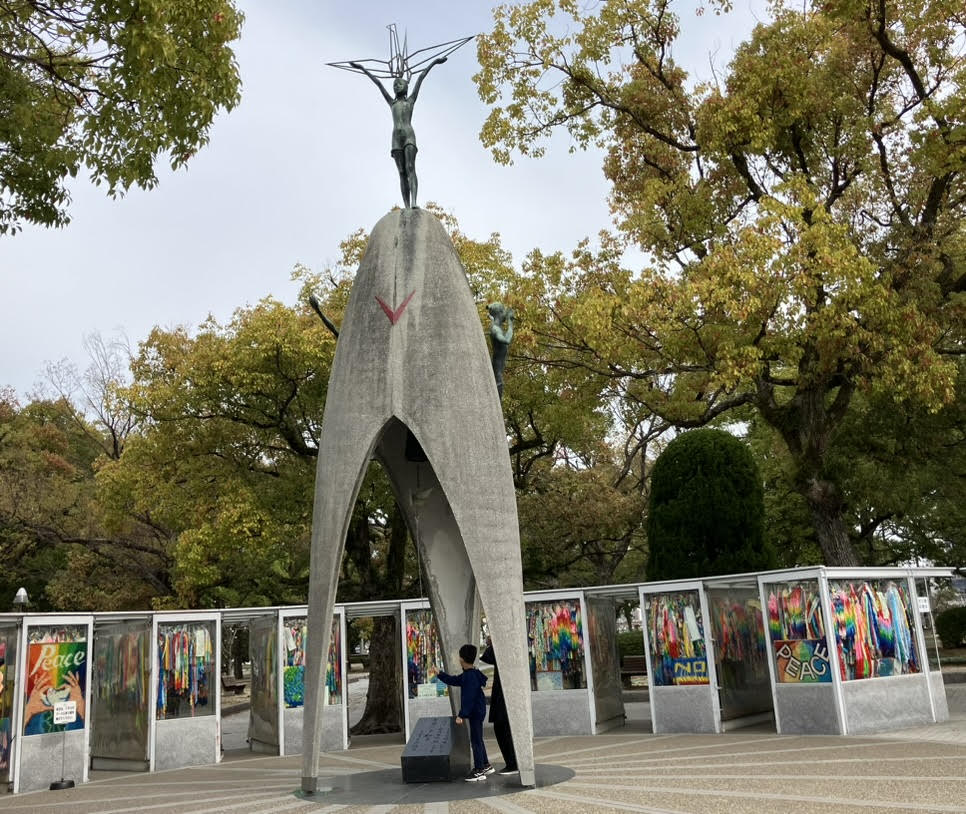80 Years after Hiroshima: High Time for a Fresh START
EDITORIAL, 4 Aug 2025
#910 | Marilyn Langlois – TRANSCEND Media Service
In On a Highway to Hell, former weapons inspector and anti-nuclear activist Scott Ritter alerted us to an ominous threshold crossed last September, warning that “by allowing the US nuclear posture to shift from deterrence to employment [under both Trump and Biden], there will be a scenario where the US will use nuclear weapons. And then it’s lights out.”
As the doomsday clock currently hovers at a mere 89 seconds to midnight, let us reflect on how we got to ground zero 80 years ago, in the interest of not only turning the clock back and preventing any future deployments but to rid the earth entirely of these demonic devices.
James F. Byrnes
The name James F. Byrnes is likely unfamiliar to all but the most assiduous World War II era historians, and certainly not one that is commonly associated with the decision to drop the first atomic bomb on Hiroshima. US President Harry Truman ultimately made the call, yet it was Byrnes who played the pivotal role in channeling the cascade of events resulting in that shameful milestone, as meticulously documented in historian Gar Alperovitz’ 1995 book The Decision to Use the Atomic Bomb.
Upon first entering Washington politics in 1935 as a US Senator from Missouri, Truman was mentored by the far more experienced Senator Byrnes from South Carolina, who had already spent 18 years in Congress, later sat briefly on the Supreme Court and held key wartime mobilization positions under President Franklin Roosevelt.
Upon Roosevelt’s death April 12, 1945, when the relatively inexperienced Truman found himself suddenly at the helm of a major war power, his former mentor was ready and willing to advise him on navigating the conclusion of the war. It was Byrnes who first informed the newly sworn in President about the top secret Manhattan Project, as he had been unaware of it while Vice President. Byrnes became an influential member of the Interim Committee of Truman’s close advisors on plans for the atom bomb and was soon appointed Secretary of State.
Multiple scenarios were floated in the Interim Committee for ending the war against Japan. By June 1945, it was already apparent to Secretary of War Henry Stimson and top US military brass that Japan was essentially defeated. Word had emerged through back channels that the Japanese had secretly sought Russian assistance in brokering a surrender with minimally face-saving terms, namely an assurance that the role of Emperor as ceremonial head of state could be preserved after their military was dismantled.
At Yalta in February, 1945, Stalin had assured Roosevelt that following Germany’s impending defeat he’d need three months to mobilize Soviet troops to enter the war against Japan in Manchuria, a move likely to result in weakened Japan’s prompt capitulation. Truman and Byrnes were ambivalent about this option, not wanting the Soviet Union, ostensibly still a US ally but already viewed by US and UK leaders with suspicion, to gain undue postwar stature. After the Soviets rolled into Berlin and the Nazi’s surrendered on May 8, Byrnes realized the window of opportunity to use the bomb, which was still under construction, would close on August 8.
Byrnes insisted that Truman postpone the Potsdam Conference of the Big Three (Truman, Churchill and Stalin) for a month, so that its start date would not precede the estimated schedule for secretly testing the new bomb to see if it actually worked. On July 16, the eve of the Potsdam, Truman quietly received word that the atomic bomb test in remote Alamagordo, New Mexico, had been successful, giving him leverage to be confident and assertive with Stalin during the ensuing discussions.
Unlike Roosevelt, who envisioned a mutually respectful co-existence with the Russians, Byrnes urged Truman to seek postwar dominance, ushering in decades of bristly Cold War tensions. For Byrnes, the primary purpose of dropping nuclear bombs on Japan was not to force its surrender, but to send a threatening message to the Soviet Union.
Debate ensued over the content of the Potsdam Declaration, an ultimatum demanding that Japan accept its terms unconditionally or face annihilation. One draft included a clause that upon Japan’s surrender its Emperor would remain in place. Stimson and other military leaders in Potsdam endorsed this, since retaining Japan’s respected Emperor would allow him to oversee an orderly demobilization of its military. Byrnes, however, fearing Japan might surrender prematurely, convinced Truman to insist this clause be deleted from the final document.
The Potsdam Declaration was signed on July 26, by Truman, Churchill and China’s Chiang Kai-shek (by wire, as he was not in attendance). Stalin did not sign, as the Soviet Union had not yet entered the war against Japan. Japan reacted with mokusatsu. meaning “to be silent”, in the sense of “withholding comment.” Secret internal Japanese cables intercepted during that time gave ambiguous messages, but Truman made no attempt to follow up and seek a prompt resolution.
On August 6, 1945, the uranium-based bomb Little Boy, use of which had already been authorized on July 25, was dropped on Hiroshima, instantly killing 166,000 and decimating the city.
On August 8, the Soviet Union declared war on Japan and marched into Japanese occupied Manchuria.
On August 9, the plutonium-based bomb Fat Man was dropped on Nagasaki., instantly killing 80,000 and decimating the city.
On August 10, Japan issued a statement accepting the terms of surrender as long as the position of Emperor was maintained. Truman initially favored accepting it.
On August 11, at Byrnes’ insistence, Truman countered with language specifying that the Emperor would remain and be subject to the Supreme Commander of the occupying allied forces.
On August 13, cables intercepted from Japanese army generals indicated Russia’s entrance into the war was a primary motivation for their surrender, with no mention of the nuclear bombs.
On August 14, Tokyo’s formal surrender, agreeing to the Potsdam Declaration terms as clarified by the US on Aug. 11, was accepted by the allies. The war against Japan ended.
It’s Personal
The story of Hiroshima and Nagasaki is personal to me. Caught up in the war fervor following the attack on Pearl Harbor in late 1941, my otherwise kind and peace-loving aunt signed up for a top-secret clerical position with the government at an undisclosed location. She and the physicist she met and married there were part of J. Robert Oppenheimer’s team in Los Alamos.
When I asked my uncle 50 years later how he felt about working on the Manhattan Project, he recalled the prevalent fear in 1942 that the Nazi’s were working on an atomic bomb, so it was important to beat them to it. This narrative disintegrated three months prior to Hiroshima, however, when Germany was defeated before the US bomb was finished. In theory, work on it could have been called off at that point, but the momentum was unstoppable, and key decision makers clearly wanted to have their new weapon.
Those who designed and built the bomb had no say in how it would be used, though some tried. In June 1945, a high level panel of atomic scientists submitted a letter to Truman’s Interim Committee, urging them not to use it on any living target, but at most to stage a demonstration deployment over the ocean or in a completely uninhabited area.
Click Here to view short video about the author’s personal pilgrimage to Hiroshima
The Myth
They say history is written by the victors. Nearly a third of Alperovitz’ 600-page tome is devoted to The Myth, in other words, narrative control, to prop up the US’ carefully crafted reputation as a force for the good and to eliminate any potential recriminations about having committed a monumental war crime.
The facts of history confirm that bombing Hiroshima and Nagasaki was both militarily and morally unjustified. The myth maintains that without the atomic bomb, Japan would not have surrendered, requiring the US to mount a massive land invasion, which would have allegedly cost up to 1,000,000 lives of American soldiers. Hence, the sacrifice of 250,000 Japanese civilians in Hiroshima and Nagasaki (not counting the thousands who died subsequently from effects of radiation), while lamentable, ended up supposedly saving lives (!) in the long run.
But this was not true. As noted above, Japan’s surrender could have been obtained without the atomic bombs. And while military commanders, to cover for every possible eventuality, had drawn up plans for a land invasion of Japan in November 1945, if necessary, none, including Stimson, believed this would ever have to be implemented. Even if it was implemented, potential US casualties were projected to reach no more than 40,000.
A key vehicle for delivering The Myth was a blockbuster article published in Harpers Magazine in February, 1947, ostensibly authored by former Secretary of War Henry Stimson, but ghostwritten by young McGeorge Bundy, under the supervision of James B. Conant, president of Harvard University and former Chair of the National Defense Research Committee. Bundy also assisted the elderly and ailing Stimson in writing his memoirs, making sure they didn’t contradict The Myth. He later rose to be National Security Advisor under Presidents Kennedy and Johnson and a key architect in escalating the Vietnam War.
Byrnes is said to have been extremely guarded, keeping his thoughts from the public and avoiding historical exposure. His key role in the decision to use the bomb soon receded into obscurity. In 1947 he conveniently had a falling out with Truman and was replaced as Secretary of State by James Marshall, who claimed a lasting legacy for financing the assurance of western Europe’s undying loyalty to the US-led capitalist bloc over the communist and non-aligned regions. Byrnes meanwhile retreated to his home state of South Carolina, where he was elected governor on a segregationist, anti-civil rights platform.
Hidden Hands
Was Byrnes entirely self-motivated in insisting on use of the bomb? Further investigation is warranted into which elements, possibly tied to US/UK imperial financial interests, might have been covertly guiding him. Presidents come and go, as do behind-the-scenes operators, but we ignore the latter and their sponsors at our own peril.
In recent years, US Presidents Biden and Trump have had us teetering on the brink of nuclear war, shamelessly enabling nuclear-armed Israel in its genocidal aggression and relentlessly taunting nuclear-armed Russia and China. Both have displayed varying levels of cognitive impairment, leaving us to wonder, who is really running the show? Who are the James F. Byrnes’ of our day and who is guiding them? More importantly, how can they be exposed and neutralized?
Urgency of Arms Control
In 2017, the Nobel Peace Prize was awarded to the International Campaign to Abolish Nuclear Weapons, a broad consortium of experts and activists around the world aiming for complete elimination of these weapons of mass destruction. Instead of this laudable movement receiving the ongoing media attention it deserves along with substantive support from both nuclear and non-nuclear nations, it has faded dangerously into the background. Let’s bring it back into the limelight!
While past arms control efforts have established important steps on the path towards full disarmament, we’ve seen considerable backsliding lately. The US withdrew from the Anti-ballistic Missile Treaty in 2000, and from both the JCPOA nuclear agreement with Iran and the Intermediate Nuclear Forces Treaty in 2018. The credibility of the International Atomic Energy Agency, the world’s nuclear watchdog organization, was severely damaged after its inspectors illegally disclosed confidential information about Iran’s peaceful nuclear energy program, which was subsequently bombed by Israel and the US.
The START (Strategic Arms Reduction Treaty) agreements have achieved significant reductions in US and Russian nuclear stockpiles over many years, yet the current version of START is set to expire in February, 2026. Unless measures are taken to commence the complex negotiations required for its renewal, massive proliferation of nuclear weapons could ensue. Scott Ritter has launched Project 38, an urgent campaign to extend the START treaty. Please support it!
In June, the US Conference of Mayors, reflecting the will of citizens in cities and towns across the country, adopted a resolution urging the United States to lead the world back from the brink of nuclear war and halt and reverse the nuclear arms race. US Director of National Intelligence Tulsi Gabbard visited Hiroshima recently, making a compelling case for arms control, but will she be heard by those with power to do something about it?
It’s high time to strengthen the anti-nuclear movement and demand a fresh START, with concrete steps towards transparent arms control on the way to comprehensive disarmament. Needless to say, we can’t allow another US president whose name begins with Trum…. to unleash a nuclear holocaust anywhere on the earth.
____________________________________________
 Marilyn Langlois is a member of TRANSCEND USA West Coast. She is a volunteer community organizer and international solidarity activist based in Richmond, California. A co-founder of the Richmond Progressive Alliance, member of Haiti Action Committee and Board member of the International Center for 9/11 Justice, she is retired from previous employment as a teacher, secretary, administrator, mediator and community advocate.
Marilyn Langlois is a member of TRANSCEND USA West Coast. She is a volunteer community organizer and international solidarity activist based in Richmond, California. A co-founder of the Richmond Progressive Alliance, member of Haiti Action Committee and Board member of the International Center for 9/11 Justice, she is retired from previous employment as a teacher, secretary, administrator, mediator and community advocate.
Tags: Alamogordo New Mexico, Atomic Weapons, Doomsday Clock, Hiroshima and Nagasaki, History, ICAN-International Campaign to Abolish Nuclear Weapons, Japan, Manhattan Project, Nuclear Abolition, Nuclear Ban Treaty, Nuclear Weapons, Nuclear Weapons Illegal, Nuclear war, Politics, Treaty on the Prohibition of Nuclear Weapons TPNW, USA, WWII
This article originally appeared on Transcend Media Service (TMS) on 4 Aug 2025.
Anticopyright: Editorials and articles originated on TMS may be freely reprinted, disseminated, translated and used as background material, provided an acknowledgement and link to the source, TMS: 80 Years after Hiroshima: High Time for a Fresh START, is included. Thank you.
If you enjoyed this article, please donate to TMS to join the growing list of TMS Supporters.

This work is licensed under a CC BY-NC 4.0 License.
5 Responses to “80 Years after Hiroshima: High Time for a Fresh START”
Write a comment to Marilyn Langlois
We welcome debate and dissent, but personal — ad hominem — attacks (on authors, other users or any individual), abuse and defamatory language will not be tolerated. Nor will we tolerate attempts to deliberately disrupt discussions. We aim to maintain an inviting space to focus on intelligent interactions and debates.


Total and permanent physical disarmament needs teaching about and for disarmament. However, physical disarmament is the temporary remedy of war weary world. Mere physical disarmament cannot remove wars unless people are disarmed psychologically. Nonviolence is more fundamental than disarmament. It is not necessary that a disarmed person would always be nonviolent. But a nonviolent person would always be disarmed. For this, we will have to introduce and implement everywhere the man-making education i.e. peace education
Nonviolence: More Fundamental than Disarmament
Surya Nath Prasad, Ph. D. – TRANSCEND Media Service
https://www.transcend.org/tms/2016/08/nonviolence-more-fundamental-than-disarmament/
Universal Peace Education: A Remedy for All Ills
Prof. Surya Nath Prasad, Ph.D.
L’Harmattan, Paris, France, May 2024
http://www.editions-harmattan.fr/livre-universal-peace-education-a-remedy-for-all-ills-surya-nath-prasad-9782140488580–80186.html
Thank you very much for your comment, reminding us of the fundamental importance of psychological disarmament in order for physical disarmament to take full effect. Point well taken!
Excellent article! I was unaware of the important role of Byrnes. I am struck by how consequential the untimely death of Roosevelt was. Thanks for this valuable historical review and call to action now.
Excellent article Marilyn. I was completely unaware of Byrnes. I learned a lot. I also Leo your impressive video. I was part of ICAN and at the UN for the TPNW Ban Treaty for which the Nobel Peace price was swarded. In addition to “psychological disarmament” in the comment above we need knowledge of Johan Galtung’s work and the Transcend Method to analyze the underlying conflict, identify legitimate goals and create a new reality that also addresses basic human needs. Also note the last Nobel Peace prize was awarded to Japanese organisation Nihon Hidankyo, bomb survivors for their work raising consciousness about the nuclear threat.
Nuclearism is a very interesting science and has many positive uses.
Nuclear weapons will disappear the day humanity refuses ALL weapons. Wars are a racket, a business, forced upon politicians, often against their will or personal choice.
Only governments have the right to purchase what the War industry produces, from the minute bullets that go inside machine guns to gigantic warships. Only governments have the right to own slaves (Armed Forces) teach them to fight , maim, torture, kill, destroy buildings, pollute land, sea and air. Only governments have the right to send their slaves on killing and destructive missions and/or to meet their own death.
All legal, because ignorant and gullible humanity believe that it is all done in the name of defense, security, protection, freedom, democracy.
We must rid the world from Militarism. Only a Police Force is needed to supervise Peace in society.
Militarism is Legal Murder. To kill 200 people with a conventional bomb is as bad as killing 10 thousand with a nuclear bomb